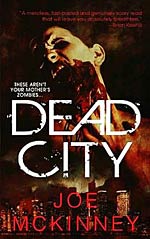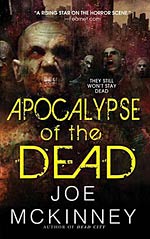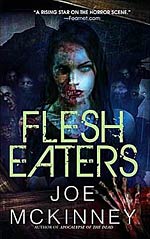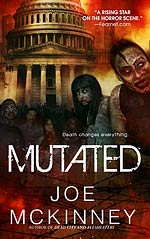The Horror! The Horror! Joe McKinney
Guest Blogger and WWEnd Member, Charles Dee Mitchell, has contributed a great many book reviews to WWEnd including his extensive Philip K. Dickathon blog series. In this series Dee explores the darker side of genre fiction and it’s practitioners. Be sure to visit his blog www.potatoweather.blogspot.com for more genre goodness.
 For an author of zombie novels, Joe McKinney has an unbeatable backstory. For the past twenty years or so, he has been a policeman in San Antonio, Texas, serving as a homicide detective, then in the office of emergency preparedness, and now overseeing the 911 division. It’s not that San Antonio has been especially prone to zombie attacks during that time, but cops have seen a lot of the worst parts of human nature. McKinney’s protagonists, who tend to be cops themselves, cannot possibly be prepared for the horrific situations they encounter, but they handle themselves cooly and professionally – at least for as long as such a response is possible. If I found myself in a zombie-infested quagmire, I would want to stay close to one of McKinney’s main characters, unless he proved to be one of the immoral bastards the author also throws into the mix.
For an author of zombie novels, Joe McKinney has an unbeatable backstory. For the past twenty years or so, he has been a policeman in San Antonio, Texas, serving as a homicide detective, then in the office of emergency preparedness, and now overseeing the 911 division. It’s not that San Antonio has been especially prone to zombie attacks during that time, but cops have seen a lot of the worst parts of human nature. McKinney’s protagonists, who tend to be cops themselves, cannot possibly be prepared for the horrific situations they encounter, but they handle themselves cooly and professionally – at least for as long as such a response is possible. If I found myself in a zombie-infested quagmire, I would want to stay close to one of McKinney’s main characters, unless he proved to be one of the immoral bastards the author also throws into the mix.
McKinney’s Dead World series consists of Dead City, Apocalypse of the Damned, and Flesh Eaters. In September, 2012, this trilogy will be joined by Mutated. McKinney’s titles let you know what you are getting. His initial trilogy has an interesting chronology. Dead City (2006) takes place in San Antonio during the night that the infection plaguing a storm-ravaged Houston first makes its way north. There are those inevitable early police reports: “We got a party getting out of hand down on the east side.” Apocalypse (2010) returns to Houston, a month or so after the city has been quarantined. Only if you have never watched a horror movie in your life, you know how well that quarantine is going to hold. The novel follows a band of escapees heading north to a settlement that promises protection for the zombie hordes. Again, unless you have never watched a horror movie in your life, you know how well that is going to work out.
The problem endemic to zombie fiction, on which the floodgates have now officially been opened, is that we have, after all, seen all this before. George Romero created Night of the Living Dead in 1968. To some extent, all zombie films and fiction are a gloss on the Romero original. (I am not counting earlier zombie works that based themselves on Haitian and voodoo motifs.) Something brings the dead back to life. The deadly extraterrestrial rays of forty years ago have been for the most part updated to hemorrhagic viruses. The infection spreads by bites or bodily fluids, victims crave human flesh, and there is no cure. The only real question that each author and filmmaker must decide is whether to create fast or slow zombies. I am in the slow zombie camp myself, but I admire McKinney’s solution. He allows for relative mobility based on the age and health of the victim.
McKinney’s prose has the no-nonsense, laconic rhythm that fits well with his police officer protagonists. The stories are predictable, but the secret here is to make each moment believable and to pace the gross outs with realistic depictions of what it is going to take for each character to live through the next hour. McKinney’s novels were getting noticed by those who give horror writing awards early on, and in 2011 he won a Bram Stocker Award for Flesh Eaters. And that third outing is definitely where he came into his own as a writer. Dead City was just like a zombie movie, except it took five hours to read instead of ninety minutes to watch. Apocalpyse succeeded in opening up the story, but the climax came directly from accounts of the Jonestown Massacre, only with zombies instead of federal agents on hand for the tragic conclusion.
Flesh Eaters goes back to Houston and the series of storms that not only destroy the city but through chemical spills and god knows what else sets in motion the infections that will change life on earth forever. Again, this is a zombie story, and so we know basically what is going to happen. But for the first time, McKinney creates morally complex characters capable of both courage and betrayal in the face of the unthinkable horrors they confront.
I am not going to become a fan of zombie fiction. The only other example I have read was the well-received novel Feed by Mira Grant and I absolutely hated it. But come September, I feel certain that I will be searching out McKinney’s latest, even though with the title Mutated I am pretty damn sure I now at least three fourths of what is going to happen.
You can read my reviews of Dead City, Apocalypse of the Damned, Flesh Eaters and Feed right here on Worlds Without End.
Adieu, DRM
 Tor has extended their DRM-free book policy across the pond:
Tor has extended their DRM-free book policy across the pond:
As of today, Tor UK, Pan Macmillan’s science fiction and fantasy imprint, has made its eBooks DRM-free and available to purchase from the Tor UK Ebookstore. In a move announced earlier this year, Tor UK has joined sister company Tor Books in New York in removing Digital Rights Management from all its titles so that once you purchase a Tor UK book, you can download it as many times as you like, on as many ereaders as you like.
Back in April, John Scalzi, this year’s Worldcon MC, applauded the decision:
As an author, I haven’t seen any particular advantage to DRM-laden eBooks; DRM hasn’t stopped my books from being out there on the dark side of the Internet. Meanwhile, the people who do spend money to support me and my writing have been penalized for playing by the rules. The books of mine they have bought have been chained to a single eReader, which means if that eReader becomes obsolete or the retailer goes under (or otherwise arbitrarily changes their user agreement), my readers risk losing the works of mine they’ve bought. I don’t like that.
Cory Doctorow believes this means the end to the format wars:
I’d expect someone to make a browser plugin that draws a “Buy this book at BN.com” button on Amazon pages (and vice-versa), which then facilitates auto-conversion between the formats. I’d also expect BN.com to produce a “switch” toolkit for Kindle owners who want to go Nook (and vice-versa).
China Miéville, speaking at the Edinburgh International Book Festival last weekend, looked beyond tearing down just DRM, predicting the remixing of content at will:
Be ready for guerrilla editors. Just as precocious 14-year-olds brilliantly – or craply – remix albums and put them up online, people are starting to provide their own cuts of novels. In the future, asked if you’ve read the latest Ali Smith or Ghada Karmi, the response might be not yes or no, but “which mix”, and why?
It’s a brave new (publishing) world that has such content in it!
GMRC Review: White Mars by Brian Aldiss
 Guest Blogger and WWEnd member, valashain, reviews science fiction and fantasy books on his blog Val’s Random Comments which we featured in a previous post: Five SF/F Book Blogs Worth Reading. Val has posted many great reviews to WWEnd and this is his eighth for the GMRC. Be sure to visit his site and let him know you found him here.
Guest Blogger and WWEnd member, valashain, reviews science fiction and fantasy books on his blog Val’s Random Comments which we featured in a previous post: Five SF/F Book Blogs Worth Reading. Val has posted many great reviews to WWEnd and this is his eighth for the GMRC. Be sure to visit his site and let him know you found him here.
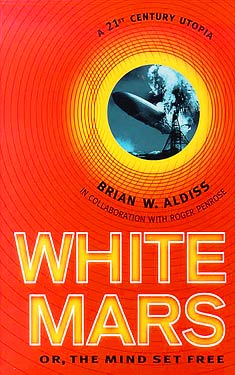 While rereading Kim Stanley Robinson‘s Mars Trilogy, books I consider to be among the very best in science fiction, I came across various references to White Mars Or, The Mind Set Free by Brian W. Aldiss, written in collaboration with prominent physicists Roger Penrose. Robinson’s utopian vision of a terraformed Red Planet is not something everybody would see as ideal or even morally acceptable. In the Mars Trilogy Robinson pays a lot of attention to the discussion between what he calls the Reds, a faction opposed to terraforming the planet and convinced of its intrinsic value, and the Green faction who would exploit the planet and make it more hospitable to human life. Aldiss (and Penrose) wrote this novel as a reply to Robinson’s vision of utopia portrayed in his Mars novels. The debate about how to set up a utopian society on Mars is the single most important topic in this book. As a nod to his source of inspiration, Robinson even had a street named after him. As far as I can tell White Mars is out of print, I had a hard time tracking down a useful copy without resorting to the countless torrents out there. After having read it, I can’t say I am terribly surprised by the relative obscurity of this book. The philosophical argument may be sound, as a work of literature Robinson’s novels are far superior.
While rereading Kim Stanley Robinson‘s Mars Trilogy, books I consider to be among the very best in science fiction, I came across various references to White Mars Or, The Mind Set Free by Brian W. Aldiss, written in collaboration with prominent physicists Roger Penrose. Robinson’s utopian vision of a terraformed Red Planet is not something everybody would see as ideal or even morally acceptable. In the Mars Trilogy Robinson pays a lot of attention to the discussion between what he calls the Reds, a faction opposed to terraforming the planet and convinced of its intrinsic value, and the Green faction who would exploit the planet and make it more hospitable to human life. Aldiss (and Penrose) wrote this novel as a reply to Robinson’s vision of utopia portrayed in his Mars novels. The debate about how to set up a utopian society on Mars is the single most important topic in this book. As a nod to his source of inspiration, Robinson even had a street named after him. As far as I can tell White Mars is out of print, I had a hard time tracking down a useful copy without resorting to the countless torrents out there. After having read it, I can’t say I am terribly surprised by the relative obscurity of this book. The philosophical argument may be sound, as a work of literature Robinson’s novels are far superior.
Since this novel is a reply to Robinson’s work I find it very difficult not to see it in the light of the Mars Trilogy. In fact, when I first heard about the novel I questioned the wisdom of trying to cover ground Robinson had already so thoroughly explored. No matter how unfair it may be to compare books of different authors to each other, this novel practically begs for it. I’m not sure how much sense this review will make if you have not read Robinson’s novels. You have been warned.
The Crooked Letter
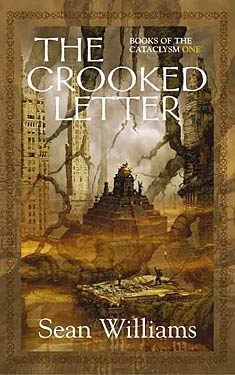 The first novel in a rather extensive fantasy series, Sean Williams’ The Crooked Letter is half kabbalistic text, half apocalyptic literature, and all around general mind twist. The plot is deceptively simple: one of a pair of twins is murdered while vacationing in Europe, which triggers the apocalypse, and both twins have to do what they can from their respective sides of death to prevent it from destroying all the worlds. In an interview about this novel, Williams jokes that if his attempt to build a fantasy world out of all his research into gnostic and world religions doesn’t pan out, he can always use it to found a new religion. He’s not far off the mark, though I doubt any of the older, self-respecting gnostic cults would have appreciated Williams publishing all of their secrets for the public.
The first novel in a rather extensive fantasy series, Sean Williams’ The Crooked Letter is half kabbalistic text, half apocalyptic literature, and all around general mind twist. The plot is deceptively simple: one of a pair of twins is murdered while vacationing in Europe, which triggers the apocalypse, and both twins have to do what they can from their respective sides of death to prevent it from destroying all the worlds. In an interview about this novel, Williams jokes that if his attempt to build a fantasy world out of all his research into gnostic and world religions doesn’t pan out, he can always use it to found a new religion. He’s not far off the mark, though I doubt any of the older, self-respecting gnostic cults would have appreciated Williams publishing all of their secrets for the public.
The plot takes a hundred detours through this terrifically complex set of worlds. If the worlds that comprise the afterlife aren’t complicated enough, even our physical world is re-envisioned as a scary realm of barely hidden monsters and deities. There’s a reason Williams calls this book “my Silmarillion” — it’s a guided tour through the worlds of magic and anti-magic, rather than being driven by a dramatic character arc. That’s not necessarily a waste of time, and his world-creation is fascinating enough to hold one’s attention for a while, but after the 300th page one starts yearning for some more common narrative arcs.
I will say that Williams has a talent for good character moments, even if they tend to get buried in the rubble of the end of the world. The love triangle between the twins and a fellow Australian traveler is heart-rending at times, made the more so when she is used as a pawn against them. There is also a prevailing sense of sadness amongst many inhabitants of the afterlife, who worry that their home world will also be destroyed in the wreckage of our world. Even a minor time travel conceit (which I generally hate) works well for the development of some characters.
It’s hard to say how many readers will like this novel. For some, like me, it might be a curiosity that they pick up once a week, spurred on by the gradually unfolding apocalypse. Others might find it entertaining to match up Williams’ characters to figures in ancient mythology (the appendix is helpful for this kind of reader). The descriptions of The Crooked Letter‘s sequels leads me to think that they follow a more popular style of story structure. He admits that this is probably his least successful book, but I can believe that Williams is a perfectly competent writer, and that his subject matter simply got the better of him in this novel. Worth your time if you don’t mind taking your time.
Grand Master Reading Challenge July Review Poll Winner: Emil Jung

![]() The July GMRC Review Poll is now closed and the winner, for the second straight month, is Emil Jung (Emil) for his review of Hothouse by Brian Aldiss. This is Emil’s third GMRC win. Well done, Sir!
The July GMRC Review Poll is now closed and the winner, for the second straight month, is Emil Jung (Emil) for his review of Hothouse by Brian Aldiss. This is Emil’s third GMRC win. Well done, Sir!
Emil will receive a T-shirt, a GMRC button and a set of commemorative WWEnd Hugo Award bookmarks, last year’s and this year’s, as well as his choice of another book from the WWEnd bookshelf. All runners-up will be getting a button and a set of bookmarks for their efforts. Thanks to all our reviewers!
The GMRC is still going strong as evidenced by the current numbers. 157 participants, 510 books read and 171 total reviews. We’ve finally left our 150 participant goal in the rear-view!
Editor’s note: This is a bit overdue because I was off on vacation last week. Sorry for the delay.
Mars Descent in Beautiful HD
Remember that very cool, but highly pixelated postage stamp sized video of the heat shield separating from our latest Mars lander? It didn’t look so crappy because NASA couldn’t afford good cameras. Rather, they didn’t have the bandwidth to send all those frames on the first day. Several dozen MRO, Mars Express, and Odyssey pass bys later, we have a spectacular HD video.
Make sure you maximize this video before watching it. Better yet, port it to your television. It’s THAT awesome.
Forays into Fantasy: The Mabinogion Tetralogy by Evangeline Walton
Scott Lazerus is a Professor of Economics at Western State Colorado University in Gunnison, Colorado, and has been a science fiction fan since the 1970s. The Forays into Fantasy series is an exploration of the various threads of fantastic literature that have led to the wide variety of fantasy found today, from the perspective of an SF fan newly exploring the fantasy landscape. FiF will examine some of the most interesting landmark books of the past, along with a few of today’s most acclaimed fantasies, building up an understanding of the connections between fantasy’s origins, its touchstones, and its many strands of influence.
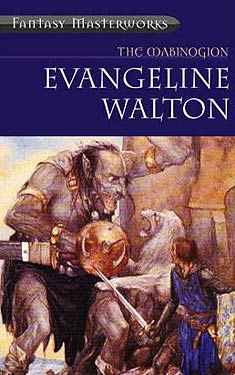 The paperback republication of The Lord of the Rings in the 1960s and its subsequent wild success created a whole new audience for fantasy, and led to a fantasy publishing boom in the 1970s. Along with spawning, for better or worse, an unending stream of new epic fantasy, the belated popularity of J. R. R. Tolkien also sent publishers looking for other older fantasy novels to reprint. One result was Ballantine’s Adult Fantasy series, which reprinted sixty-five novels between 1969 and 1974, under the editorship of Lin Carter. Books by Lord Dunsany, Clark Ashton Smith, H. P. Lovecraft, William Hope Hodgson, James Branch Cabell, and many others now considered fantasy classics were brought back into print and released as affordable paperbacks for fantasy-hungry readers. One of Carter’s more obscure finds was the eighteenth book in the series, The Island of the Mighty by Evangeline Walton, a novelistic retelling of the fourth “branch” of the Mabinogion—a series of Welsh-language legends of the British Isles dating from the fourteenth century, the stories themselves most likely originating in the twelfth. Though it had received some critical acclaim on release in 1936 under its original unfortunate (though not inaccurate) title The Virgin and the Swine, it had failed to sell and was pretty well forgotten by the time Carter brought it to Ballantine’s attention.
The paperback republication of The Lord of the Rings in the 1960s and its subsequent wild success created a whole new audience for fantasy, and led to a fantasy publishing boom in the 1970s. Along with spawning, for better or worse, an unending stream of new epic fantasy, the belated popularity of J. R. R. Tolkien also sent publishers looking for other older fantasy novels to reprint. One result was Ballantine’s Adult Fantasy series, which reprinted sixty-five novels between 1969 and 1974, under the editorship of Lin Carter. Books by Lord Dunsany, Clark Ashton Smith, H. P. Lovecraft, William Hope Hodgson, James Branch Cabell, and many others now considered fantasy classics were brought back into print and released as affordable paperbacks for fantasy-hungry readers. One of Carter’s more obscure finds was the eighteenth book in the series, The Island of the Mighty by Evangeline Walton, a novelistic retelling of the fourth “branch” of the Mabinogion—a series of Welsh-language legends of the British Isles dating from the fourteenth century, the stories themselves most likely originating in the twelfth. Though it had received some critical acclaim on release in 1936 under its original unfortunate (though not inaccurate) title The Virgin and the Swine, it had failed to sell and was pretty well forgotten by the time Carter brought it to Ballantine’s attention.
As explained in publisher Betty Ballantine’s introduction to Overlook’s 2002 omnibus edition of The Mabinogion Tetralogy (also published under the Fantasy Masterworks banner, of which The Island of the Mighty is the fourth and final book, Ballantine’s desire to publish the novel set in motion a heartwarming series of events. Having initially been informed that the book’s copyright had expired, and having searched fruitlessly for Walton, Ballantine prepared the work for publication, finding out at the last minute that the copyright had in fact been renewed, and that Walton was alive and well and living in Phoenix. Walton’s childhood had been marked by illness that kept her in her home, and medical treatments that resulted in a skin condition that would make her reluctant to appear in public later in life. Seeking refuge in books, she developed a love of fantasy and medieval literature, leading to a determination to retell The Mabinogion as a series of fantasy novels.
Harry Harrison, R.I.P.
Harry Harrison, author of such series as The Stainless Steel Rat and Bill, the Galactic Hero, and 2009 Damon Knight Memorial Grand Master Award inductee, passed away today.
See the author’s site for the official notice.
Harrison’s author page on WWEnd. Notable works: Make Room! Make Room!, The Stainless Steel Rat, Bill, the Galactic Hero.
See also io9’s tribute article.
Addled by the Adler
Those of you who are attending this year’s Worldcon in Chicago probably already know about the opening night event at the Adler Planetarium. If you don’t, then maybe this news will be enough to entice you to come join us. If you do attend, please come visit us at the fan tables section! In the meantime, enjoy this little video I found about the attraction. Although the Adler is stuffed with state-of-the-art shows and interactive exhibits, the main attraction to me is the history of the building itself. It is the oldest planetarium in North America, and has an impressive collection of antique observational equipment. Steampunk fans, rejoice!
From the Chicon 7 web site:
Chicago, Illinois, USA – Chicon 7, the 70th World Science Fiction Convention (“Worldcon”), will offer its members a spectacular opening night event at the Adler Planetarium.
On Thursday, August 30, Chicon 7 will be taking over the Adler Planetarium for an evening reception for convention members. This exclusive event will run from 6:30 to 10:30 p.m., during which time the museum will be closed to the general public.
During the reception, Chicon members can view the museum exhibits. In addition, the Grainger Sky Theater will be running the show “The Searcher” every 30 minutes. This show was written by Nick Sagan (son of astronomer Carl Sagan) and follows the story of a visitor from another galaxy as he searches for his lost civilization. It features stunning visualizations of the formation of our universe, the collision of galaxies, a spectacular supernova explosion, and a supermassive black hole. (Seating in the theater is limited, so there will be a $5 charge for admission to this performance.) Weather permitting, the museum will also host a sky-viewing session on its exterior deck, with telescopes and docents provided to members so they can see the wonders waiting in the night sky.
Museum campus parking will be available, and shuttle buses will run between the Adler Planetarium and the Hyatt Regency throughout the evening.
About the Adler Planetarium:
The Adler Planetarium was the first modern planetarium in the Western Hemisphere and first opened to the public on May 12, 1930. The museum houses extensive exhibits on space science including one of the world’s most important antique astronomical instrument collections. The Adler is also a recognized leader in science education, with a focus on inspiring young minds to pursue careers in science. The museum sits on the extreme edge of Chicago’s “museum campus” and is located on an artificial island.
How the Angels See the Universe
Be sure to watch it in HD! Here’s the video description on YouTube:
This animated flight through the universe was made by Miguel Aragon of Johns Hopkins University with Mark Subbarao of the Adler Planetarium and Alex Szalay of Johns Hopkins. There are close to 400,000 galaxies in the animation, with images of the actual galaxies in these positions (or in some cases their near cousins in type) derived from the Sloan Digital Sky Survey (SDSS) Data Release 7. Vast as this slice of the universe seems, its most distant reach is to redshift 0.1, corresponding to roughly 1.3 billion light years from Earth. SDSS Data Release 9 from the Baryon Oscillation Spectroscopic Survey (BOSS), led by Berkeley Lab scientists, includes spectroscopic data for well over half a million galaxies at redshifts up to 0.8 — roughly 7 billion light years distant — and over a hundred thousand quasars to redshift 3.0 and beyond.
For more information about BOSS and the latest data release, go to http://newscenter.lbl.gov/news-releases/2012/08/08/boss-sdss-dr9/.



















 Full Details
Full Details
